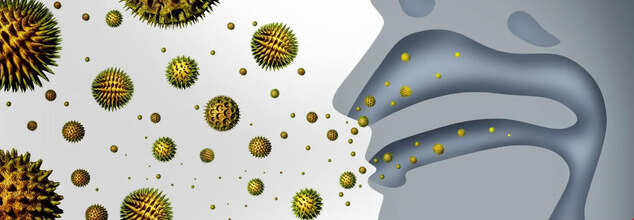- Health Conditions A-Z
- Health & Wellness
- Nutrition
- Fitness
- Health News
- Ayurveda
- Videos
- Medicine A-Z
- Parenting
- Web Stories
New RNA-Based TB Detection Could Soon Take Minutes, Not Months

Tuberculosis (TB) is a deadly global health crisis despite being a curable disease. In 2023 alone, TB killed about 1.25 million people globally — more than any other infectious pathogen. While the ability of months- or years-long courses of antibiotics to kill Mycobacterium tuberculosis, the bacteria that cause the disease, treatment success is not certain for all. In fact, in approximately 12% of patients, TB recurs even after treatment.
The major roadblock is that clinicians today lack a specific test to see if TB bacteria were completely removed from the body by treatment. Failing to have accurate monitoring mechanisms, doctors have to implement the same six-month treatment regimen in all patients and accept that some will be over-treated and some will be failures. However, all that may soon change, thanks of a breakthrough RNA-based TB detection test that Dr. Kayvan Zainabadi, assistant professor of molecular microbiology at Weill Cornell Medicine, and his India-based team are developing.
Modern TB treatment protocols are dependent on clinical experience and sputum-based diagnostic procedures that identify bacterial DNA. However, these procedures are fraught with limitations. Despite the successful treatment, residual bacterial DNA can continue to be present in the patient's system, resulting in false positives and making it difficult to clearly perceive the status of the disease.
This diagnostic imprecision compels physicians to remain with a "one-size-fits-all" six-month treatment regimen, even when evidence indicates that most patients might be cured earlier. Long-term exposure to highly effective antibiotics not only risks patients developing side effects but also places a heavy burden on healthcare systems, particularly in low-resource settings where TB is most prevalent.
Dr. Zainabadi’s research introduces a groundbreaking concept: using ribosomal RNA (rRNA) as a rapid, sensitive, and accurate marker of TB infection. Unlike DNA, RNA is inherently less stable and degrades quickly after bacterial death, minimizing the risk of false positives.
The innovation is aimed at the detection of the 16S rRNA of Mycobacterium tuberculosis, which is a part essential to bacterial protein synthesis. Its prevalence in the cell makes it a prime target for detection even in small or difficult-to-access samples.
Significantly, this RNA-based method might overcome the sputum reliance that is sometimes tricky to obtain from high-risk populations such as children or HIV-infected individuals. Rather, less intrusive sample forms might be utilized, providing a more patient-centered, convenient, and scalable platform.
How Does It Work?
The RNA test operates by extracting 16S rRNA from patient samples and amplifying it using highly sensitive molecular methods. Since rRNA degrades quickly after bacterial cells die, detecting it gives real-time feedback regarding the presence of active TB infection — something DNA-based tests cannot consistently provide.
In practice, a sample would be taken from the patient (possibly from gastric fluid, blood, or other more readily accessible fluids) and run through the RNA detection system. If live bacteria are present, the 16S rRNA signature would show up in the test results, providing clinicians with an instant readout of disease activity.
The rapidity and precision of this methodology may significantly reduce diagnostic turnaround times from weeks or months to mere minutes or hours. This results in quicker clinical decisions, more targeted interventions, and substantial reductions in patient anxiety and healthcare expenditures.
Is It More Helpful Than Other Diagnostic Tests?
In comparison to conventional sputum microscopy and DNA-based molecular diagnostics, the RNA-based test has a number of revolutionary benefits.
First, its ability to target active infection — not just bacterial residue — prevents patients from being subjected to unnecessary or excessive treatment. This specificity is especially important in combating multidrug-resistant TB, where inappropriately using antibiotics exacerbates resistance problems.
Secondly, the fact that it can accept non-sputum samples makes it much more convenient. It is not possible for several children and immunocompromised individuals to produce sufficient sputum, and clinicians are left with the option of using invasive and less effective gastric lavage methods. An RNA-based test would equalize access to proper TB diagnosis among these high-risk populations.
Third, in the field of TB drug discovery, this test might be a game-changer. Rather than waiting two years to determine if a drug is effective, researchers would be able to monitor bacterial clearance in real-time, moving clinical trials forward more quickly and lowering costs.
Lastly, at a macro health systems level, a quick, precise, and less intrusive diagnostic device would be a game-changer for TB-endemic countries where resources are tightly constrained and the disease burden is highest.
The stakes are as high as they could possibly be. TB has continued to be a recalcitrant worldwide killer, too often fueled by diagnostic ambiguity and treatment inefficacy. An RNA-based diagnostic test such as the one Dr. Zainabadi and his colleagues are creating is not only an incremental step but a potential paradigm shift in how we combat the disease.
As the study continues, the expectation is that this new technology will not only revolutionize individual patient treatment but also redefine the public health sector in the global fight against tuberculosis.
Valley Fever Cases Surge In California-How To Identifiy This Lung Infection

Credit: Canva
California may be heading toward another record year of Valley fever infections, with early 2025 data already showing a troubling increase in reported cases. Health officials have confirmed over 3,100 infections across the state—figures that surpass last year’s numbers for the same period and nearly double those recorded in 2023.
Valley fever, medically known as coccidioidomycosis, is a serious lung infection caused by the Coccidioides fungus, which thrives in the dry, dusty soils of the western U.S. California, where the disease was first identified, consistently reports the highest number of cases nationwide. If left untreated, the illness can lead to severe, long-term respiratory issues and even death if it spreads to the brain.
“There is no question that the number of cases is enormously higher than before,” said Dr. Royce Johnson, director of the Valley Fever Institute at Kern Medical. “If you want to see me, you’d have to wait until July, and that goes for my colleagues, too,” he told NBC News, highlighting the growing strain on healthcare systems in affected regions.
The majority of recent infections have been reported in Kern, Los Angeles, Monterey, and Fresno counties—areas long known as hotspots. But the illness is now expanding its reach. In Contra Costa County, located in the East Bay region, cases have tripled compared to 2023. Nearby Merced and San Bernardino counties are also reporting significant spikes.
“It appears to be spreading out,” noted Gail Sondermeyer Cooksey, an epidemiologist with the California Department of Public Health.
Valley fever infections occur when people inhale spores released into the air from soil containing Coccidioides. These spores can be stirred up by wind, construction, and agricultural activities. While anyone can get infected, those most at risk include people over 60, individuals with weakened immune systems, pregnant women, diabetics, and those of Black or Filipino descent. Outdoor workers also face higher exposure.
Symptoms typically resemble those of the flu and may include fatigue, cough, fever, shortness of breath, and skin rashes. While most recover, about 10 percent develop chronic lung issues, and approximately 1 percent experience dissemination of the infection to the skin, bones, joints, or brain.
Health experts also point to a concerning link between climate change and the disease's rising prevalence. Shifts from prolonged drought to intense rain—common in California’s recent weather patterns—create favorable conditions for the fungus to grow and later release spores as the land dries.
“As climate change alters the timing and intensity of precipitation in California, we see longer high-risk periods for Coccidioides exposure,” said Simon Camponuri, a PhD researcher at the University of California, Berkeley.
With forecasts predicting a hot and dry summer following recent floods and mudslides, health officials are bracing for continued spikes in Valley fever cases in the coming months. Public health campaigns are urging increased awareness, especially among vulnerable populations and those living in high-risk regions.
GLP-1 Drugs Fight Fat, Curb Appetite And May Also Reduce Cancer Risk

What if the one injection that is helping you lose weight and manage diabetes also protect you from cancer? That's the surprising promise emerging from a new study on GLP-1 drugs, drugs already drawing attention for their ability to battle obesity and regulate blood sugar. Now scientists have discovered a potential new advantage: a much reduced risk of cancers related to obesity.
While the global use of GLP-1 agonists such as Saxenda and Byetta is gaining speed, this research unlocks a thrilling new era in preventive care. But just how do such medications function and why could they be protecting us against cancer?
After once being touted as miracle drugs for treating obesity and type 2 diabetes, GLP-1 medications such as Saxenda and Byetta are now uncovering a new benefit: a reduced risk of cancer. New research in the journal eClinicalMedicine identifies that these initial weight-loss medications may have more to their credit than just reducing waistlines—they can cut the risk of developing obesity-linked cancers by a dramatic 41%.
This finding has the potential to change forever the way that we think about the wider ramifications of GLP-1 treatments, particularly in a world where metabolic diseases are closely associated with cancer susceptibility. But why might this new benefit exist? And how do these drugs actually work?
What Are GLP-1 Drugs and How Do They Work?
GLP-1 agonists (glucagon-like peptide-1 receptor agonists) are a type of drug that mimics the effect of an endogenous hormone involved in the modulation of appetite, blood glucose levels, and digestion. Initially approved for the treatment of type 2 diabetes, they've become very popular due to their capacity to cause weight loss by reducing hunger and slowing gastric emptying.
Drugs such as liraglutide (Saxenda) and exenatide (Byetta) are usually given through subcutaneous injection. Newer forms, including semaglutide (Ozempic) and tirzepatide (Zepbound), have greater efficacy in weight loss and metabolic control, although they were not part of this specific study.
GLP-1 acts via a cascade of hormonal action:
- It triggers the release of insulin from the pancreas, lowering blood sugar.
- It inhibits the release of glucagon, a hormone that increases blood sugar.
- It reduces the rate at which the stomach empties following meals.
Perhaps most importantly for managing weight, it sends satiety messages to the brain to make people feel fuller for longer.
Missing Link Between Cancer Risk and Obesity
Both type 2 diabetes and obesity are firmly established as risk factors for many forms of cancer, such as breast, colon, uterine, pancreatic, and liver cancer. This can be explained by the chronic inflammation, insulin resistance, and hormonal imbalance that accompany excess fat stores.
For their new study, scientists from Clalit Health Services in Tel Aviv, Israel, analyzed electronic health records of more than 6,300 adults age 24 and above. Everyone involved had both type 2 diabetes and obesity and received either GLP-1 medication or weight-loss surgery between 2010 and 2018. The group was followed through to December 2023 to record cancer diagnoses.
During a median follow-up of 7.5 years, approximately 300 individuals developed cancer of the obesity type—predominantly breast (26%), colon (16%), and uterus (15%).
GLP-1 vs. Surgery
Although bariatric surgery has been the obesity treatment gold standard for decades—and was in turn found to lower cancer risk—scientists discovered obesity-associated cancers were equal in both the surgery and GLP-1 groups. This was unexpected because surgery tends to induce greater and more immediate weight loss.
Still, additional statistical examination found that the GLP-1 medications offered a 41% lower risk of cancerous developments than surgery indicated that their anti-cancer benefit might extend beyond weight loss alone.
Reason Behind the Anti-Cancer Effect
According to co-lead researcher Dr. Dror Dicker, who heads the Obesity Clinic at Hasharon Hospital-Rabin Medical Center, the anti-cancer effects of GLP-1 drugs likely stem from multiple mechanisms. “Reducing inflammation, improving insulin sensitivity, and altering cellular growth pathways may all play a role,” he noted in a news release.
While more recent, more powerful GLP-1 medications such as Ozempic and Zepbound were not included in the study, researchers are convinced they may provide even stronger protective effects. However, additional long-term studies are necessary to determine their impacts on cancers that are not related to obesity.
Can It Change Cancer Treatment?
This new evidence indicates a paradigm shift of foundational importance in the way we think about metabolic health interventions. GLP-1 medications could soon be hailed not merely as weight-loss supplements or treatments for diabetes but as prevention against one of the world's most dreaded illnesses.
Nevertheless, prudence is still advisable. Long-term experience with these drugs is lacking, and their side effects, including nausea, gastrointestinal upset, and possible hazards for thyroid tumors, need to be weighed. A boxed warning is now placed on the list of the FDA for some GLP-1 drugs for thyroid C-cell tumors, although this has so far been seen most commonly in animal models.
With the worldwide obesity epidemic on the rise, so is the need to know how drugs such as GLP-1 agonists can change not only waistlines, but also long-term health endpoints. The notion that a single class of medication might lower the risk of cancer in addition to managing blood glucose and reducing appetite is revolutionary.
Additional research, particularly with next-generation GLP-1 drugs, will be necessary to more fully investigate and validate these benefits but for the time being, this study introduces an exhilarating and promising new chapter at the nexus of cancer prevention and obesity treatment.
Not Cholesterol: Surprising Chemical In Shampoo Bottles Tied To Heart-Related Deaths In India

Credit: Canva
Thousands of Indians die every year from heart disease. Now you may link it to high cholesterol and a lack of physical exercise, but the reality is different. According to researchers, these deaths are a result of exposure to a harmful chemical that is present in shampoos, food containers and all other common household plastic products.
A recent study published in The Lancet eBioMedicine has identified a significant link between exposure to di-2-ethylhexyl phthalate (DEHP)—a chemical commonly used to make plastics more flexible—and heart disease deaths. Surprisingly, among the 200 countries evaluated, India had the highest burden of DEHP-linked cardiovascular deaths and accounted for almost a third of the global mortalities.
What Is DEHP?
DEHP is prevalent in numerous household items, including food containers, medical equipment, toys, shampoos and lotions. The study, conducted by researchers at NYU Langone Health, analysed urine samples and environmental data from over 200 countries and territories. They found that in 2018, DEHP exposure was associated with around 356,238 deaths among individuals aged 55 to 64, accounting for over 13 per cent of global heart disease deaths in that age group. The researchers attributed India's elevated mortality to the rapid expansion of its plastics industry, widespread use of DEHP-containing products and weaker regulatory controls compared to some other nations.
It is estimated that chemicals in plastic were linked to nearly 350,000 heart disease deaths across the world in 2018. Adding to that, is this study published in the journal eBioMedicine, which estimated that roughly 13 per cent of cardiovascular deaths among 55- to 64-year-olds worldwide that year could be attributed to phthalates.
Where Are Phthalates are esters of phthalic acids, which are added to plastics to increase their flexibility, transparency, durability, and longevity. They are found in personal care products like shampoos and lotions as well as in food containers and packaging. It is also possible to ingest them through food, absorb them through skin from products containing them or breathe them from dust.
Study Shows Phthalates Increase Risk of Heart Diseases
Some studies have shown an association between phthalates and cardiovascular disease, but there isn’t strong evidence to show that the chemicals directly cause heart issues, said Sung Kyun Park, a professor of epidemiology and environmental sciences at the University of Michigan School of Public Health. However, there is enough evidence that states that phthalates increase the risk of metabolic disorders like obesity and Type 2 diabetes, which can cause cardiovascular disease. One way phthalates may do this is by increasing oxidative stress—cell and tissue damage that happens when there are too many unstable molecules in the body—and by promoting inflammation.
© 2024 Bennett, Coleman & Company Limited




